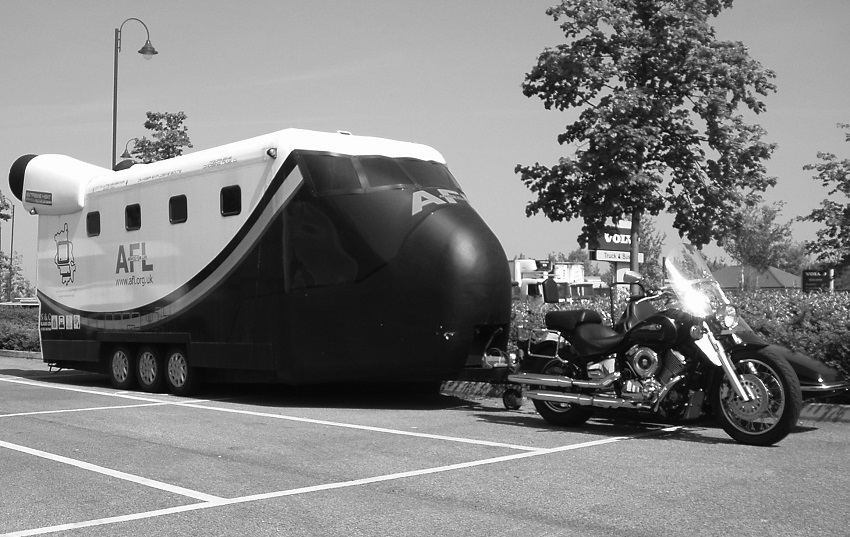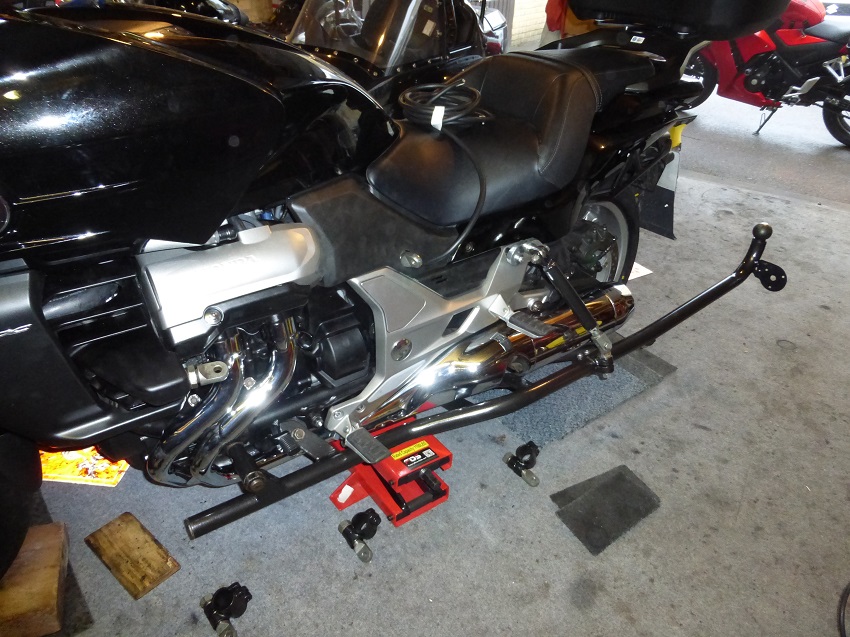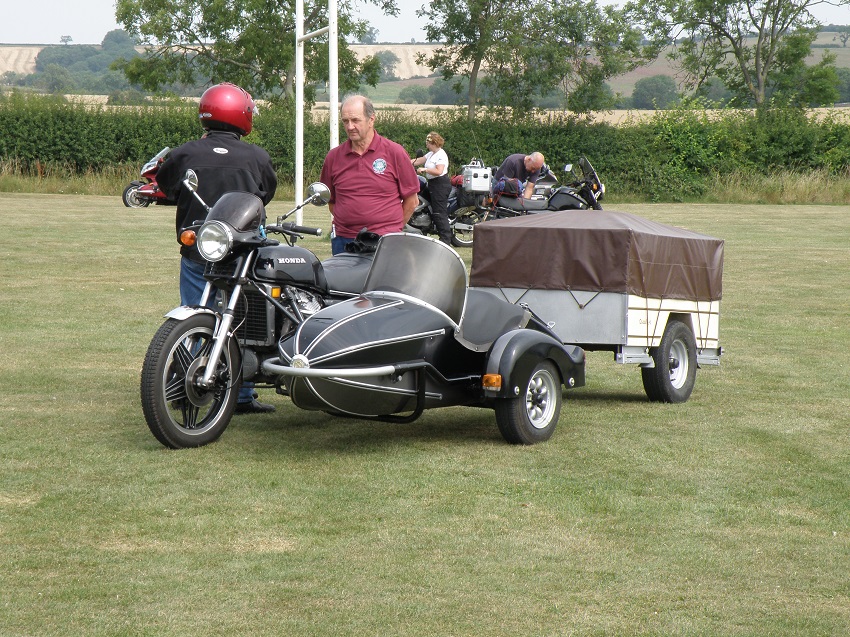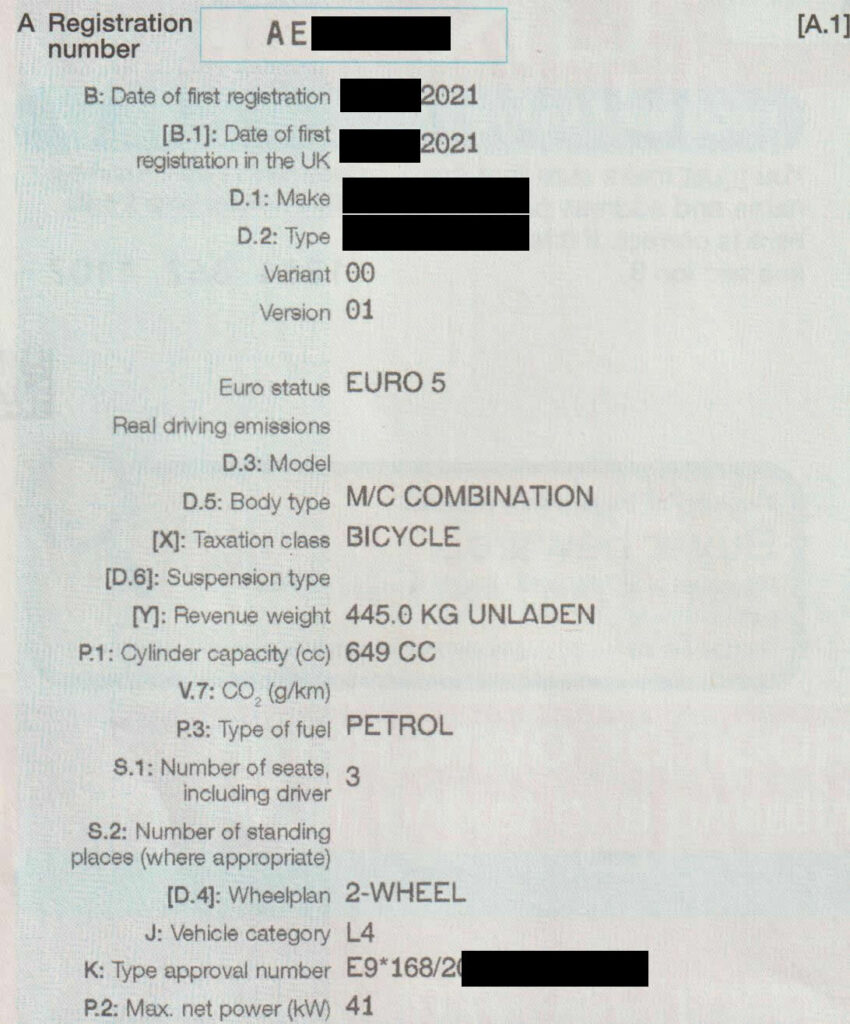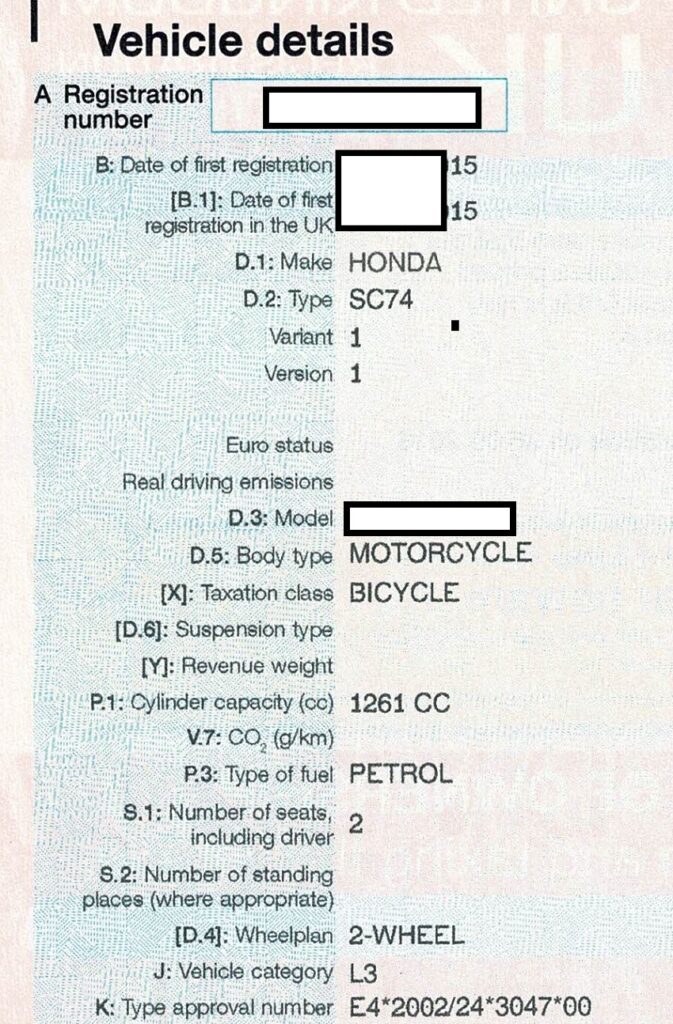Trailer towing behind your sidecar outfit.
Notes; this article is advice only. Some legalities may contradict others as new laws are passed, I suggest you contact the relevant authorities for individual questions and clarification before you tow a trailer.
The towing of trailers behind sidecars in the UK has got to be one of the most talked about subjects within the UK sidecar community, so before we go any further, I will list the specific paragraphs that cover trailers from the Construction and Use regulations, if you require the full regulation simply click on this link https://www.legislation.gov.uk/uksi/1986/1078/contents/made
The following information has been taken from the current Road Vehicle (Construction and Use) Regulations 1986.
TABLE (regulation 8(1))
| 1 | 2 | 3 |
| Item | Class of Vehicle | Maximum Width (metres) |
| 1 | A locomotive, other than an agricultural motor vehicle. | 2.75 |
| 2 | A refridgerated vehicle. | 2.58 |
| 3 | Any other motor vehicle. | 2.5 |
| 4 | A trailer drawn by a motor vehicle having a maximum gross weight (determined as provided in Part I of Schedule 8 to these Regulations) exceeding 3500 kg. | 2.5 |
| 5 | An agricultural vehicle. | 2.5 |
| 6 | An agricultural trailed appliance. | 2.5 |
| 7 | Any other trailer drawn by a vehicle other that a motor cycle. | 2.3 |
| 8 | A trailer drawn by a motor cycle. | 1.5 |
(2) Paragraph (1) does not apply to a broken down vehicle which is being drawn in consequence of the breakdown.
(3) No person shall use or cause or permit to be used on a road a wheeled agricultural motor vehicle drawing a wheeled trailer if, when the longitudinal axes of the vehicles are parallel but in different vertical planes, the overall width of the two vehicles, measured as if they were one vehicle, exceeds 2.5 metres.
(4) In this regulation “refrigerated vehicle” means any vehicle which is specially designed for the carriage of goods at low temperature and of which the thickness of each of the side walls, inclusive of insulation, is at least 45 mm.
Trailers drawn by motor cycles
84.- (1) Save as provided in paragraph (2), no person shall use, or cause or
permit to be used, on a road a motor cycle-
(a) drawing behind it more than one trailer;
(b) drawing behind it any trailer carrying a passenger;
(c) drawing behind it a trailer with an unladen weight exceeding 254 kg;
(d) with not more than 2 wheels, without a sidecar, and with an engine
capacity which does not exceed 125 cc, drawing behind it any trailer;
or
(e) with not more than 2 wheels, without a sidecar and with an engine
capacity exceeding 125 cc, drawing behind it any trailer unless-
(i) the trailer has an overall width not exceeding 1 m;
(ii) the distance between the rear axle of the motor cycle and the
rearmost part of the trailer does not exceed 2.5 m;
(iii) the motor cycle is clearly and indelibly marked in a conspicuous
and readily accessible position with its kerbside weight;
(iv) the trailer is clearly and indelibly marked in a conspicuous and
readily accessible position with its unladen weight; and
(v) the laden weight of the trailer does not exceed 150 kg or two
thirds of the kerbside weight of the motor cycle, whichever is the less.
(2) The provisions of paragraph (l)(b), (d) and (e) do not apply if the trailer
is a broken down motorcycle and one passenger is riding it.
Unbraked Trailers
87:- (1) Save as provided in paragraph (2), no person shall use, or cause or permit to be used, on a road and unbraked wheeled trailer if –
(a) its laden weight exceeds its maximum gross weight; or
– it is drawn by a vehicle of which the kerbside weight is less than twice
the sum of the unladen weight of the trailer and the weight of any load which trailer is carrying.
(2) This regulation does not apply to-
(a) an agricultural trailer; or
(b) a trailer mentioned in regulation 16 (3) (b) to (g)
Braking systems of vehicles to which regulation 15 does not apply
16.- (1) Save as provided in paragraph (2) and (3). This regulation applies to every vehicle to which regulation 15 does not apply.
(2) Paragraph (4) of this regulation does not apply to a vehicle which complies with regulation 15 by virtue of the proviso to regulation 15(1), or which complies with community directive 79/489 or ECE regulations 13.03, 13.04 or 13.05.
(3) This regulation does not apply to the following vehicles, except in the case of a vehicle referred to in (a) insofar as the regulation concerns parking brakes (requirements 16 to 18 in Schedule 3)-
(a) a locomotive first used before 2nd January 1933, propelled by steam, and with an engine which is capable of being reversed.
(b) a trailer which-
(i) is designed for use and used for street cleaning and does not carry any load other than its necessary gear and equipment.
(ii) has axle weights of which the sum does not exceed 750Kg;
(iii) is an agricultural trailer manufactured before 1st July 1947 drawn by a motor tractor or an agricultural motor vehicle if the trailer-
(A) has a laden weight not exceeding 4070kg
(B) is the only trailer being drawn; and
(C) is drawn at a speed not exceeding 10mph; or
(iv) is drawn by a motor cycle in accordance with regulation 84,
(c) an agricultural trailed appliance;
(d) an agricultural trailed appliance conveyor;
(e) a broken down vehicle;
Regulation 75(1)
| 1 | 2 | 3 |
| Item | Class of vehicle | Maximum permitted laden weight |
| (kg) | ||
| 1 | A wheeled heavy motor car or motor car which is not described in items 2, 4 or 5 and which complies with the relevant braking requirement | The weight specified in column (5) of Part I of Schedule 11 in the item which is appropriate, having regard to columns (2), (3) and (4) in that Part |
| 2 | A wheeled heavy motor car or motor car (not being an agricultural motor vehicle) which forms part of an articulated vehicle and which complies with the relevant braking requirement | The weight specified in column (5) in Part II of Schedule 11 in the item which is appropriate having regard to columns (2), (3) and (4) in that Part |
| 3 | A wheeled trailer, including a composite trailer, but not including a semi-trailer, which is drawn by a motor tractor, heavy motor car or motor car which complies with the relevant braking requirement, other than a trailer described in items 6, 7, 8 or 11 | As for item 1 |
| 4 | A bus | The weight specified in column (5) of Part I of Schedule 11 in the item which is appropriate having regard to columns (2), (3) and (4) in that Part, the laden weight of the bus being calculated in the manner described in regulation 78(3) to (5) |
| 5 | A wheeled agricultural motor vehicle | As for item 1, but subject to a maximum of 24,390 |
| 6 | A balanced agricultural trailer, as defined in paragraph (4), which is not described in items 8, 11 or 16 | As for item 1, but subject to a maximum of 18,290 |
| 7 | An unbalanced agricultural trailer, as defined in paragraph (4) which is not described in items 8, 11 or 16 | 18,290 inclusive of the weight imposed by the trailer on the drawing vehicle |
| 8 | A wheeled trailer manufactured on or after 27th February 1977 and fitted with brakes which automatically come into operation on the over-run of the trailer (whether or not it is fitted with any other brake), except an agricultural trailer which is being drawn by an agricultural motor vehicle, which complies with the requirements specified in items 3, 14 and 17 of Schedule 3 and of which the brakes can be applied either by the driver of the drawing vehicle or by some other person on that vehicle or on the trailer | 3,500 |
There you have the regulations, but how do you interpret them? Let’s look at width. In table 8 (1) under “Trailer drawn by a Motor Cycle” it states max width 1.5m. We now have to establish what is a motorcycle. Under regulation 3 (2) “Motor Cycle” a mechanically propelled vehicle, not being an invalid carriage, having less than four wheels and the weight of which unladen does not exceed 410 kg. Before I hear “my Goldwing outfit weighs more than that” I will point out the latest 6 cylinder monster has an official kerb weight of 367kgs Specifications – Gold Wing Tour – Touring – Range – Motorcycles – Honda . Please note; no accessories are included; a sidecar is classed as an accessory so not included in the motorcycle’s kerb weight.
So, the regulation definition covers anything with 3 wheels or less that doesn’t exceed 410kgs, for example, Trikes, Outfits, and yes, solos, but don’t get excited thinking you can tow a trailer 1.5m wide behind your solo motorcycle or outfit just yet.
Further with-in the regulation there is a specific paragraph (84) covering trailers drawn by Motor Cycles.
Here it states, 84 (1) (i) the trailer has an overall width not exceeding 1m. You may now think well why have this paragraph when width is covered in the table 8 (1). I will explain.
You will also see under paragraph 84(e) that it states with not more than 2 wheels, without a sidecar and with an engine. So that means that paragraph 84(e) is specific to 2 wheeled motorcycles regardless if it has a sidecar attached or not. Basically, “has your motorcycle got 2 wheels, without a sidecar attached?” “If the answer is yes”, it falls under paragraph 84 for towing regulations.
Trailer width, if you have a motorcycle weighing 410kgs or less with no more than 3 wheels you can tow a trailer 1.5m wide (max), if you have a 2 wheeled motorcycle you can only tow a trailer 1m wide (max).
Here is now the biggest bone of contention on the rally field. Is an Outfit a 2 wheeled vehicle or three wheeled vehicle? Many moons ago, in the days of the “Log Book” I believed you may have had to inform the DVLA that you had fitted a sidecar but that was a long time ago, when that ceased to be I don’t know. I have seen some old V5’s which have 2 wheeled combination stated, in fact I had one but had it changed when I removed the sidecar from the bike, so I know for a fact the term “combination” was and has been used for vehicle type on the V5. Under today’s regulations you don’t have to inform the DVLA that you have fitted a sidecar, as it is classed as an accessory. ( see update later within this article)
Towing a trailer; after various correspondence with various authorities (DVLA, DVSA, DFT) in the past this is what I basically got back;
We interpret the regulations to mean; A motorcycle/sidecar combination is treated as a 2 wheeled motorcycle and can tow a trailer not exceeding one metre wide. A tricycle is treated as a 3 wheeled motorcycle and can tow a trailer not exceeding 1.5m wide.
I did put it to them, that in paragraph 8 table 8(1) states motorcycles, max width 1.5 m. They responded stating “the table refers to tricycles. Two wheeled motorcycles (with or without sidecar) are covered under paragraph 84. I then responded it doesn’t state Tricycles, it just states motorcycles and could be interpreted that as an Outfit has 3 wheels it falls under table 8 (1). Their response was simple, only a court of law can establish that fact and if an offence has been committed. Basically, I think what they are saying is, if you were charged by the police with an offence in regards to towing that ultimately the court will determine how the regulations apply in regards to the offence in question and if you have actually committed an offence. (please see grey area of contradictory information at the end of this article)
Now, out on the road and the police, basically with all the rules and regulations it is very hard for the average policeman / women to know all of them off hand so to speak and from over the years don’t appear to be bothered in regards to 1.5m trailer being towed behind an Outfit, maybe because there is not much difference between 1.5m and 1m. They do have more pressing issues out on the road, dangerous driving, mobile phone use, drugs, no tax, no mot and no insurance (insurance, I will explain later in regards to trailers)
What they will look out or though is, over loading, over weight, far too wide or far too long, basically does it look safe to be on the road. I do know of someone being stopped for two of the above while towing a trailer tent with their Outfit, they were not charged but simply given words of advice to go straight home and not be seen with it on the road again.
Let’s look at weight; Take that Goldwing Outfit mentioned earlier, you have to use its official listed kerb weight of 367kgs. (note; accessories cannot be included or added). Paragraph 84(v) the laden weight of the trailer does not exceed 150 kg or two thirds of the kerbside weight of the motor cycle, whichever is the less. So, two thirds of 367 = 244.6kgs, but the maximum the Goldwing can tow is 150kgs as it is less than 244.6kgs. Now let’s look at something smaller like the Jawa 350 OHC, it has a kerb weight of 160Kgs Jawa 350 OHC UK Information (jawamotorcycles.co.uk) so, two thirds of 160 = 106.6kgs, as it is less than 150kgs you have to use the lower weight of 106.6kgs for the motorcycle’s maximum towing weight.
Laden weight defintion; https://www.lawinsider.com/dictionary/laden-weight
You will also find under regulation 84 (c) drawing behind it a trailer with an unladen weight exceeding 254 kg; I will explain, this weight applies to all motorcycles and referring to the definition it covers anything with 3 wheels or less. You must read on and simply not assume you can tow a trailer weighting 254kgs behind a solo or motorcycle combination.
84 (e) with not more than 2 wheels, without a sidecar and with an engine capacity exceeding 125 cc, drawing behind it any trailer unless—(v) the laden weight of the trailer does not exceed 150 kg or two thirds of the kerbside weight of the motor cycle, whichever is the less.
So where else can we find advice, here are a couple of useful links.
UK Motorbike Towing Law | What Trailer can you tow? (camperlands.co.uk)
Towing with a motorbike – GOV.UK (www.gov.uk)
Remember I mentioned insurance earlier; If you are involved in an accident or incident while towing a trailer, if it is found that your trailer doesn’t comply with the regulations and was a contributory factor (e.g. overweight / oversize) it could possibly have far greater implications, plus your insurance company may even refuse to pay out in the event of a claim. Please take a look at this page on one of the UK leading insurers website Best motorcycle camper trailers for your holiday – Bikesure
To sum up towing a trailer behind your Outfit: – maximum width 1m, maximum length is the distance from the rear wheel spindle to the back of the trailer and must not exceed 2.5m. Maximum towed weight must not exceed 150 Kgs or two thirds of the motorcycles kerbside weight, whichever is the least. There are a few other requirements, the motorcycle must be marked with its kerbside weight and the trailer must be marked with its unladen weight. Lighting regulations are the same as for other small trailers.
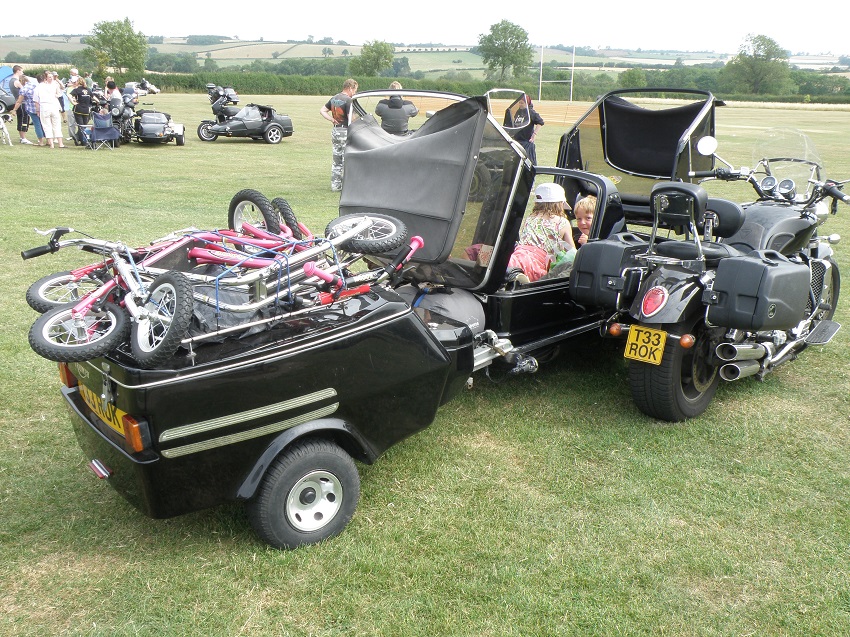
https://freewheeleng.co.uk/pullman/
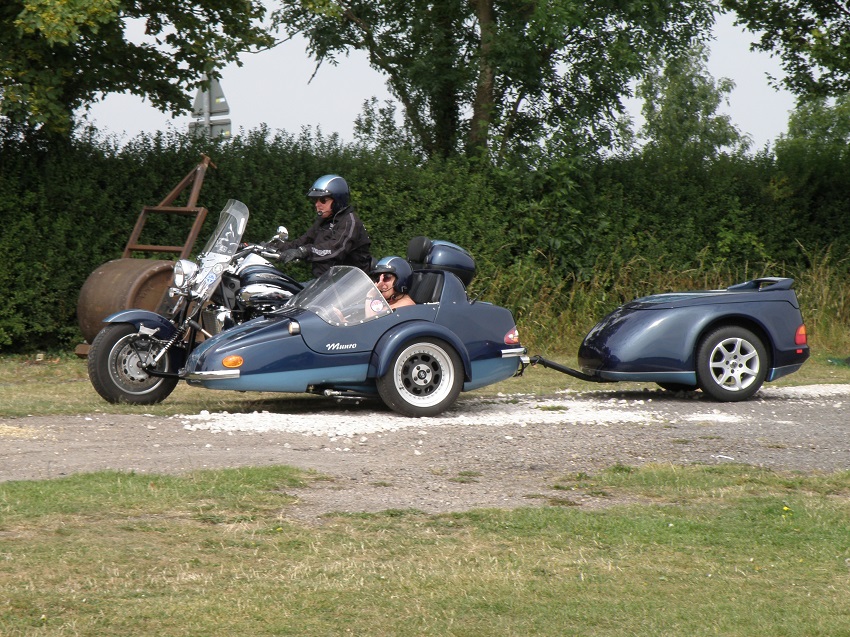
EZS Sidecars – EZS Sidecars (ezs-sidecar.com)
I will leave you to ponder this; you have a motorcycle and sidecar, you have it MOT’ed. If you have a simple basic connection system and run the solo in standard form (e.g. standard motorcycle wheels and tyres and no fancy subframe or steering mods etc) you can remove the sidecar and you can re-attach the sidecar with relative ease. Meaning you can use it as a solo through summer and simply attach the sidecar for the winter, it was done in the past, though I doubt many do this nowadays. But my point is why would you think you can tow a heavier trailer when you have now attached a sidecar weighing anything from 70 to 150kgs to the bike that still has the same brakes. Take the Royal Enfield 500 (kerb weight 187kgs), you add a sidecar weighting approx 95kgs and a trailer 115kgs then 2 people and also a sidecar boot full of kit. It might well be perfectly legal but, at the end of the day, it is not what you can tow it is all about what you can stop.
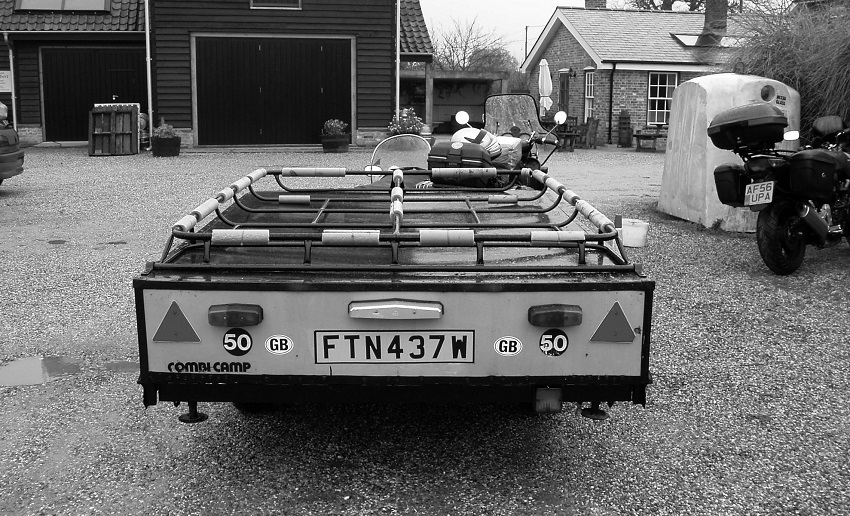
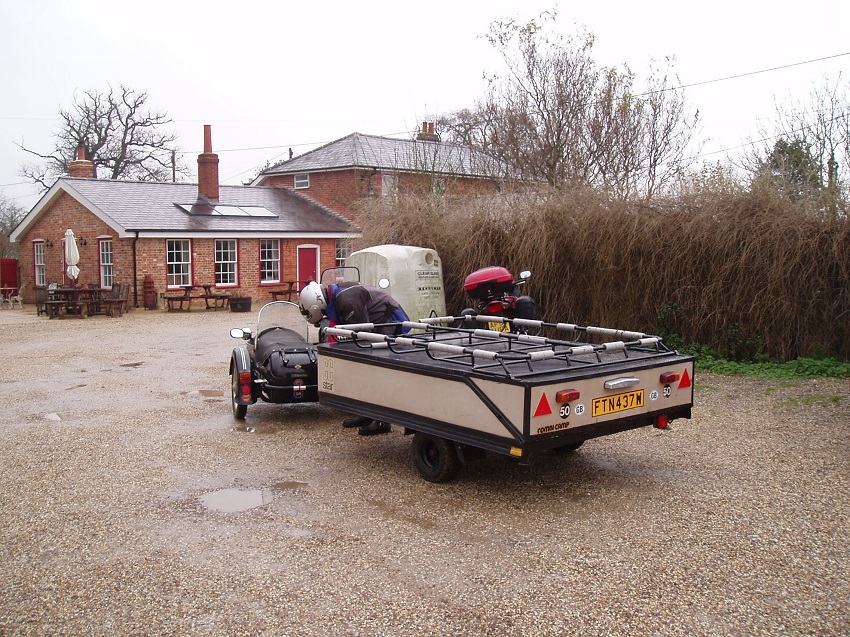
Don’t be surprised if you get stopped by the police out on the road towing a trailer with a width of 1.7m and an ex works weight of 175kgs.
The R65 has kerb weight 210kgs, to which has been added trailer 175kgs, sidecar 90kgs and around 40kgs of kit. So we have an additional 305kgs of weight to stop on brakes that where basically designed to stop 210kgs. You will here this saying again, “it is not about what you can pull, it is all about WHAT YOU CAN STOP.
Having towed a trailer on numerous occasions here are 3 tips.
Tow bar, I have found this need to be fitted as close to the motorcycle as possible, width of the outfit will have some bearing on this as your overall maximum width including the trailer must not exceed 2.5m.
The tow ball needs to be as close to the rear of the motorcycle as possible.
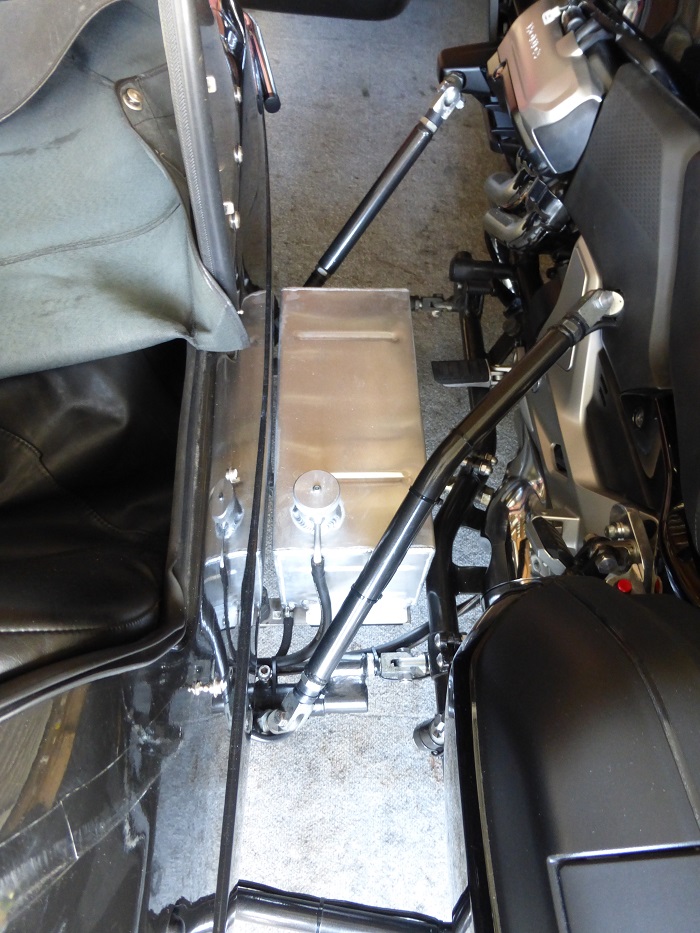
Consider a sidecar brake, while not a requirement, believe you me, it does help.
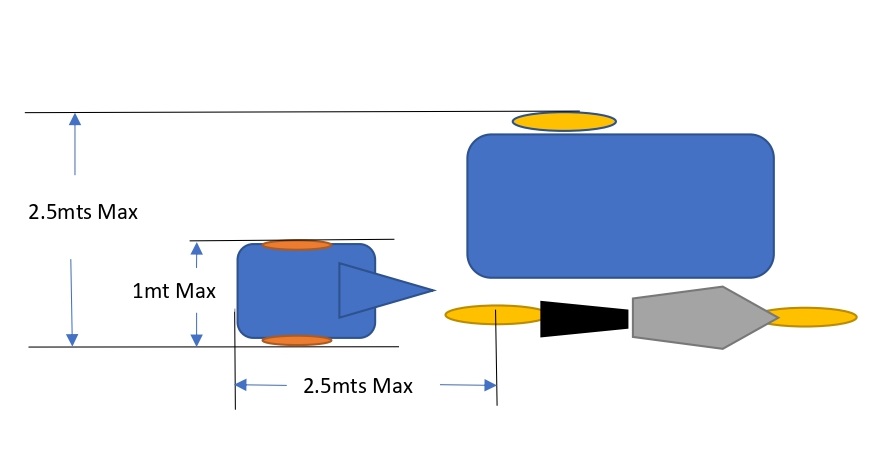
If you think it is all over, well not quite.
The latest revelation in the last few years is the three wheeled motorcycles / scooters being produced by well known manufacturers like the Yamaha Tricity 300 or Niken, Peugeot Metropolis or MP3.
I will just focus on the Niken and Tricity.
MOT inspection manual: motorcycles – Introduction – Guidance – GOV.UK (www.gov.uk)
2. Application ( Classes 1 and 2 ) Other than for the inspection of tyres, any two wheels of a motorcycle shall be regarded as one wheel if the distance between the centres of the areas of contact between the wheels and the road surface is less than 460mm.
The Niken, the front two wheels are 410mm apart, less than 460mm, so it is class as a single front wheel, (2 wheeled motorcycle) while the Tricity 300 the front 2 wheels are 470mm apart, more than 460mm, so is classed as a tricycle (3 wheeled motorcycle). Towing with a Niken the regulations would be as a solo (2 wheeled motorcycle) and towing with a Tricity 300 in fall under paragraph 8.Table 8 (1). Meaning the Tricity 300 can tow a wider and heavier trailer than the 900cc Niken. It is amazing how much different 10mm can make……
Yep, it is a little odd that the regulations mean that the smaller Tricity 300 can tow a bigger trailer than the Niken 900 but regulations are there simply to set the required parameters, e.g width, weight etc etc.
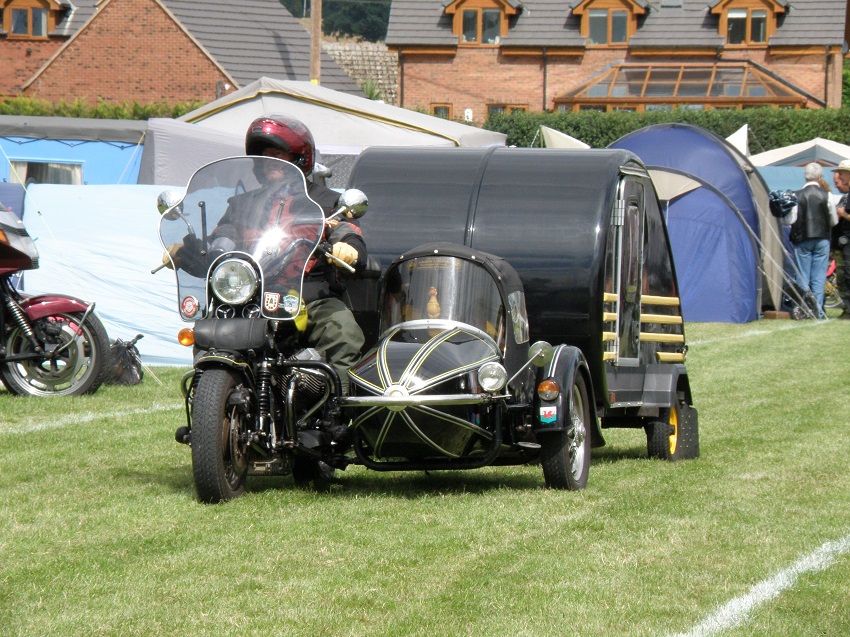
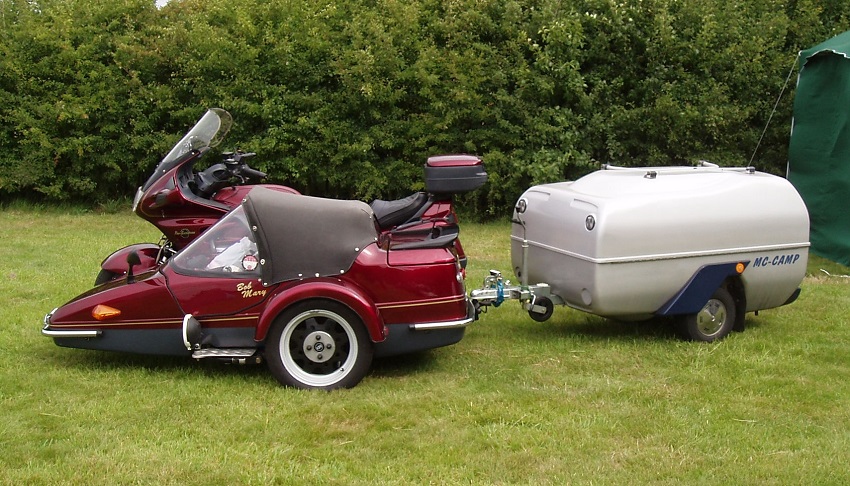
http://www.blueskyholdings.co.uk/comanche_mc_camp.html
Please note; the above covers most sidecar outfits in the UK, namely ones that you purchase a motorcycle and fit or have fitted to it, a sidecar. (see update below)
There will be a minority of combinations that are registered on the V5 that differ from what is in this article for example 2 wheeled drive Ural Outfits and those who have managed to register Ural 2 wheel drive Outfits with the sidecar on the right hand-side after the 1st Aug 1981. I suggest you contact the relevant authorities and seek clarification before you tow a trailer.
Update
I have kindly been given permission to use a copy of a current V5 of a motorcycle combination registered in 2021, where it has been registered as a complete Outfit at new. (e.g. Ural or Chang Jiang)
Chang Jiang are available from F2 motorcycles http://www.f2motorcycles.ltd.uk/chang_jiang_pekin_express.html
It is clear, even though it has a sidecar fitted at new, presented and sold as a complete Outfit, it is still classed as a 2 wheeled vehicle; see Wheelplan “2 wheel”.
Taken from the MSVA inspection manual,
Motorcycles 2 wheeled vehicles (L3e & L4e) • with (L4e) or without (L3e) sidecar
Motor Tricycles 3 wheeled vehicles (with 3 symmetrically arranged wheels) (L5e)
For comparison I have, below an example of a V5 for a motorcycle to which after purchased a sidecar was attached
There are a couple of notable differences and an omission; differences Number of seats and Vehicle category and omission is revenue weight.
Firstly, category, L4 and L3; this is determined when the vehicle is presented and first registered here is a link to the L-Category Vehicles, dubbed Powered Light Vehicles (PLV).
Revenue weight; this is not necessarily the vehicles kerb weight, (note; you may have to consult the manufacturers specifications to obtain the vehicles kerb weight) see Vehicle Excise and Registration act below https://www.legislation.gov.uk/ukpga/1994/22/section/60A#:~:text=%5BF160A%20Meaning%20of%20%E2%80%9Crevenue%20weight%E2%80%9D.&text=(b)in%20the%20case%20of,travelling%20on%20a%20road%20laden.
And here is that grey area of contradictory information.
After various correspondence, recently with various authorities, some interpret ‘84 (e) with not more than 2 wheels, without a sidecar and with an engine’. To mean (due to the comma) that 84 (e) only applies to motorcycles that are not fitted with a sidecar.
They say, regulation 8 refers to maximum permitted width but regulation 84 is specific in relation to different types of motorcycles. Regulation 8 refers to the maximum permitted width but not specific variants and that regulation 84 refers to specific types of motorcycles and solos (no sidecar)
Their interpretation is as follows; If a solo motorcycle has an engine capacity exceeding 125cc it is permitted to tow a trailer provided it meets the conditions listed of which the maximum width is 1m. If the motorcycle is fitted with a sidecar and has an engine capacity exceeding 125cc that would be permitted to tow a trailer to the maximum permitted width of 1.5m.
My view on the above;
There is no mention, reference or definition of the term Solo motorcycle within the regulations. The above interpretation implies regulation 84 (e) applies only to solo motorcycles (no sidecar) 1m and that a motorcycle and sidecar falls under “regulation 8 table 8(1) (Motorcycles) 1.5m”, it must do as that is the only place it mentions the 1.5m width in the regulation.
What about length?
Now taking into account the above, that some say 84 (e) refers to solo motorcycles (no sidecar), therefore, for motorcycle with sidecar attached 84(e) doesn’t apply for length so you have to use regulation 7 (the same as using regulation 8 for width). Having corresponded with the authorities they say, “no, because it refers to motor vehicles”, so I look up the definition at the beginning of the C and U regs. “Motor vehicle — a mechanically propelled vehicle intended or adapted for use on roads”. That covers everything doesn’t it, motorcycle, trike, car, bus, tractor, lorry!
What about weight?
I can fully accept that you can use ‘84 (c) drawing behind it a trailer with an unladen weight exceeding 254 kg’, as it pertains to all motorcycles as it comes before 84 (e). Again, for a motorcycle with sidecar you can’t use 84(e) for weight, you have to use regulation 87 unbraked trailers ‘(b)it is drawn by a vehicle of which the kerbside weight is less than twice the sum of the unladen weight of the trailer and the weight of any load which the trailer is carrying’. Basically, half the weight kerb of the motorcycle and or regulation 75 table (1) 8 for braked trailers. Having corresponded with the authorities, again they say no “because 87 is also referring to motor vehicles rather than motorcycles, they also say, regulation 84 is specific to motorcycles and is restricted due to the stability of a motorcycle compared to that of 4 wheeled motor vehicles. I do have to question that response as, there is no reference in regulation 87 to what specific type of vehicle/s it applies to (e.g. 4 wheeled) also under 84 (e) you can tow two thirds the unladen weight, but under 87 you can only tow one half. Therefore regulation 87 is more restrictive than 84 in regards to an unbraked trailer.
One would think, if regulation 84 (e) doesn’t apply to motorcycle with sidecar attached, in regards to width, it doesn’t apply in regards to length and weight as well. But and this is a big but, every correspondence with the authorities I have had state you have to use 84 (e) for length and weight as 84(e) is specific to motorcycles. So if that’s the case, you have to use 84 (e) for width as well. You simply can’t pick and choose what regulation you use just to suit your needs.
I must emphasise that this is advice only and is not intended to be an interpretation of the law and only a court of law is able to give a legal, definitive interpretation of the regulations.
Tri-Anglia Wheels Sidecar Club (Sidecarland) assume no responsibility or liability for any injury, loss or damage incurred as a result of any use or reliance upon the information and material contained within or used from its website.

